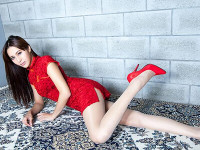iOS中实现模糊效果
来源:互联网 发布:围住神经猫源码 编辑:程序博客网 时间:2024/05/16 14:56
iOS中实现模糊效果的方法有多种,本文介绍两种。
1. 使用CoreImage实现
CoreImage框架最早出现于iOS5,后期苹果又对这个框架进行了扩展。
CoreImage框架中的常用类:
1. CIImage:代表图片的对象。
2. CIFilter:代表滤镜的对象,通过key/value的方式设置参数。
3. CIContext:用来渲染CIImage 。
下面我们来看看简单它的简单使用。
创建CIImage对象。
- (CIImage *)ciImage{ if (!_ciImage) { _ciImage = [[CIImage alloc]initWithImage:[UIImage imageNamed:@"image"]]; } return _ciImage;}创建CIFilter滤镜对象。
- (CIFilter *)filter{ if (!_filter) { //传入滤镜的名字即可使用类方法创建 _filter = [CIFilter filterWithName:@"CIGaussianBlur"]; } return _filter;}现在的SDK中包含了很多种滤镜,那么我们怎么知道具体有哪些滤镜呢?又怎么知道每一种滤镜的具体用法呢?百度?谷歌?当然可以,但是还有另一种方法。
我们从CIFilter的头文件中可以看到滤镜有很多种分类,名字都是以kCICategory…开头,我们可以通过CIFilter的类方法得到对应分类下的所有滤镜。以kCICategoryBuiltIn为例,获取这个分类下的滤镜:NSArray *filters = [CIFilter filterNamesInCategory:kCICategoryBuiltIn];NSLog(@"filters = %@",filters);//打印出来filters = ( CIAccordionFoldTransition, CIAdditionCompositing, CIAffineClamp, CIAffineTile, CIAffineTransform, .....}选择好自己需要的滤镜之后,再通过查看滤镜的属性来了解它的用法。以高斯模糊滤镜为例:
_filter = [CIFilter filterWithName:@"CIGaussianBlur"];NSLog(@"attribute = %@",[_filter attributes]);打印的结果
attribute = { "CIAttributeFilterAvailable_Mac" = "10.4"; "CIAttributeFilterAvailable_iOS" = 6; CIAttributeFilterCategories = ( CICategoryBlur, CICategoryStillImage, CICategoryVideo, CICategoryBuiltIn ); CIAttributeFilterDisplayName = "Gaussian Blur"; CIAttributeFilterName = CIGaussianBlur; CIAttributeReferenceDocumentation = "http://developer.apple.com/cgi-bin/apple_ref.cgi?apple_ref=//apple_ref/doc/filter/ci/CIGaussianBlur"; inputImage = { CIAttributeClass = CIImage; CIAttributeDescription = "The image to use as an input image. For filters that also use a background image, this is the foreground image."; CIAttributeDisplayName = Image; CIAttributeType = CIAttributeTypeImage; }; inputRadius = { CIAttributeClass = NSNumber; CIAttributeDefault = 10; //默认模糊度为10 CIAttributeDescription = "The radius determines how many pixels are used to create the blur. The larger the radius, the blurrier the result."; CIAttributeDisplayName = Radius; CIAttributeIdentity = 0; CIAttributeMin = 0; CIAttributeSliderMax = 100; //最高模糊度100 CIAttributeSliderMin = 0; //最低模糊度0 CIAttributeType = CIAttributeTypeScalar; };}大概说一下高斯模糊滤镜的属性,也是设置滤镜相关参数时的key:
CIAttributeFilterAvailable_iOS:iOS最低可用系统版本。
CIAttributeFilterCategories:该滤镜所属分类。
inputImage:输入的图像为CIImage对象。
inputRadius:模糊程度的参数,类型为NSNumber,默认模糊度为10,最低0,最高100。
了解了这几个属性使用高斯模糊就没问题了。创建CIContext对象。
在iOS平台下创建CIContext的方式有多种,这里介绍两种。创建基于CPU的CIContext对象:
_context = [CIContext contextWithOptions:@{kCIContextUseSoftwareRenderer:@(YES)}];创建基于GPU的CIContext对象。
_context = [CIContext contextWithOptions:nil];
采用基于GPU的CIContext将可以获得更好的性能,但是基于GPU创建的CIContext跨应用使用时会自动降为基于CPU的。比如,在进入相册选择相片的时候,如果在UIImagePickerControllerDelegate的代理方法中使用CIContext对象处理图像,系统就会把这个任务交给CPU做。
三个对象创建好之后就可以对图像做处理了。
//设置滤镜输入的图像//注意:这里的key可以写kCIInputImageKey,也可以写@“inputImage”[self.filter setValue:self.ciImage forKey:kCIInputImageKey];//设置高斯模糊的模糊程度//这里的key可以写kCIInputRadiusKey,也可以写@“inputRadius”。[self.filter setValue:@(value) forKey:kCIInputRadiusKey];//得到处理后的图片CIImage *outImage = [self.filter valueForKey:kCIOutputImageKey];CGImageRef cgImage = [self.context createCGImage:outImage fromRect:[outImage extent]];//显示图片self.blurImage.image = [UIImage imageWithCGImage:cgImage];CGImageRelease(cgImage);
效果图如下 
2. 使用UIVisualEffectView实现
UIVisualEffectView是iOS8开放的接口,使用比较简单。大概用法就是创建一个UIVisualEffectView的视图,将其放于需要添加blur效果的视图上面即可。
我们举个例子来看看UIVisualEffectView的简单使用。
UIImage *image = [UIImage imageNamed:@"1.jpg"];UIImageView *imageView = [[UIImageView alloc]initWithFrame:CGRectMake(0, 0, image.size.width, image.size.height)];imageView.image = image;[scrollView addSubview:imageView];scrollView.contentSize = image.size;//blurViewUIBlurEffect *blurEffect = [UIBlurEffect effectWithStyle:UIBlurEffectStyleExtraLight];UIVisualEffectView *visualEffectView = [[UIVisualEffectView alloc]initWithEffect:blurEffect];visualEffectView.frame = CGRectMake(0, 0, self.view.frame.size.width, 300);[self.view addSubview:visualEffectView];这段代码在scorllView上添加了一张大图,然后在scrollView上添加了一个blur效果视图。可以看出UIVisualEffectView的使用方法还是很简单的。
1. UIVisualEffectView初始化的时候需要以一个UIVisualEffect对象为参数,但是通过查看它的头文件发现它并没有除继承自NSObject之外的属性和方法。但是它又两个子类UIBlurEffect和UIVibrancyEffect,我们可以传入这两个子类的对象来初始化UIVisualEffectView。
2. UIBlurEffect:看其名字就知道它是用来实现模糊效果的。创建的模糊效果有三种风格:
UIBlurEffectStyleExtraLight,UIBlurEffectStyleLight,UIBlurEffectStyleDark 3.UIVibrancyEffect:主要用于让处于UIVisualEffectView上的内容看起来更加生动,它需要和UIBlurEffect一起使用。接上面的代码,我们在blur视图上面添加一张图片,并让图片显示也会有特殊效果,如下代码:
//创建UIVibrancyEffect对象UIVibrancyEffect *vibrancyEffect = [UIVibrancyEffect effectForBlurEffect:blurEffect];UIVisualEffectView *vibrancyEffectView = [[UIVisualEffectView alloc]initWithEffect:vibrancyEffect];vibrancyEffectView.frame = visualEffectView.bounds;//将有UIVibrancyEffect效果的视图添加到visualEffectView.contentView上[visualEffectView.contentView addSubview:vibrancyEffectView];//添加图片 UIImage *logoImage = [UIImage imageNamed:@"logo"];UIImageView *logo = [[UIImageView alloc]initWithImage:logoImage];logo.frame = CGRectMake(0, 0, logoImage.size.width, logoImage.size.height);logo.center = visualEffectView.center;[vibrancyEffectView.contentView addSubview:logo]; 效果图如下:
本文Demo
CoreImage推荐阅读:使用coreImage滤镜
UIVisualEffectView推荐阅读:
使用UIVisualEffectView为视图添加特殊效果
iOS 8 UIVisualEffectView(注:日语写的,不过看看例子不错)
- iOS中实现模糊效果
- iOS 7中实现模糊效果
- iOS 7中实现模糊效果
- iOS 7中实现模糊效果
- iOS 7中实现模糊效果教程
- iOS实现模糊效果
- iOS 模糊效果实现
- iOS 实现模糊效果
- iOS模糊效果实现
- iOS 模糊效果实现
- iOS 如何实现模糊效果
- iOS 如何实现模糊效果
- iOS 模糊效果的实现
- iOS模糊效果的实现
- iOS 中 视图模糊效果
- iOS开发中模糊效果的实现方案
- 【iOS】iOS下高斯模糊效果的实现
- iOS简单实现图片模糊渐变效果
- 视频编辑组姓名王春贺2017.12.11-2017.12.15
- ViewPager简单介绍(一)
- 数组push之后赋值给新变量之后输出为数字问题
- Kotlin 一个好用的新功能:Parcelize
- 五大开源MySQL管理工具!
- iOS中实现模糊效果
- c语言基础05
- c++ 类的继承与派生
- 头部属性 Meta http-equiv 大全
- SSM项目从零开始到入门010-mybatis提供的动态代理实现过程探究
- 细说malloc()函数
- spring cloud (一) 简介与服务调用
- django 登陆
- iOS-学习笔记(1)


